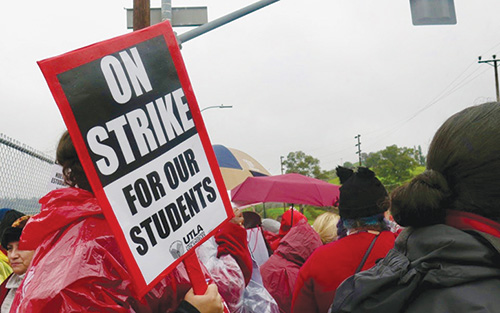OPINION: Bargaining for the Common Good: Teachers unions are fighting for the whole community

 By JOSEPH McCARTIN
By JOSEPH McCARTIN
The week-long strike by the United Teachers of Los Angeles (UTLA) in January marked the most significant struggle yet in a movement by teachers and other public-sector workers called Bargaining for the Common Good.
By striking over a long list of community-generated demands and with the support of a dense network of allies, L.A. teachers moved bargaining away from the union-versus-taxpayer framework into which public employers routinely push such conflicts. Instead, UTLA made itself the spearhead of an effort to reshape L.A.’s priorities around a common good agenda.
Drawing on several years of experimentation by public-sector unions around the country, and coming hard on the heels of the #RedforEd teachers’ uprisings of 2018, the L.A. strike illuminated a significant shift in union strategies, one that holds profound implications for the future of Organized Labor and the relationship of unions to working-class communities.
ISSUES BEYOND SALARIES
Judged by the “pure-and-simple” union standards of a generation ago, the UTLA strike might have been deemed a failure because it did not add a penny to the six percent raise the L.A. school board offered teachers before the walkout.
The strike was anything but a failure. The union fought over issues that went far beyond salaries, issues at the heart of public education and its centrality to the aspirations of working-class Angelenos – and to everyone else nationwide.
The teachers won commitments from the school district to reduce class sizes by four students per teacher by 2021, increase investment in the schools, hire school nurses and full-time librarians, reduce standardized testing and random searches of students and launch a dedicated hotline for immigrant families who need legal assistance.
They also won demands to turn the district’s brass away from promoting charter schools, an ineffective alternative to public schools which robs them of funds they need to educate their students, while putting their teachers’ futures at the whims of bosses – often private for-profit advisory firms.
Many of these demands were crafted with allies like the Association of Californians for Community Empowerment (ACCE), and they explicitly challenged the austerity agenda of L.A. School Superintendent Austin Beutner, a wealthy investment banker the school board installed in 2018 despite having no prior experience in education.
GIVING COMMUNITY A VOICE AT THE TABLE
The UTLA strike was the most recent in a string of post-Great-Recession public-sector union battles that consciously attempted to rethink the participants, processes and purposes of collective bargaining. If mid-20th-century collective bargaining was binary, involving only employers and unions, more recent efforts have sought to give community stakeholders a voice at the bargaining table.
If traditional bargaining was done behind closed doors and focused on issues like salary, these fights have been waged in public around broader demands. And if traditional bargaining concluded with signed contracts and the demobilization of the union’s membership, these efforts made bargaining one step in an ongoing strategy of worker and community empowerment.
CHANGE TRIGGERED BY THE GREAT RECESSION
This approach can be traced back to the depths of the Great Recession when Democratic President Barack Obama’s agenda became mired in the politics of austerity and Tea Party activism installed anti-union Republican governors like Wisconsin’s Scott Walker and anti-union gerrymandered GOP-run legislatures nationwide.
It also tightened the grip of austerity on all levels of government, as those governors and lawmakers cut taxes for the rich while starving schools, roads and other public services. In that toxic environment, some public-sector unions began to realize they could no longer do business as usual.
That realization helped elect Karen Lewis and her Caucus of Rank-and-File Educators slate to the leadership of the Chicago Teachers Union (CTU) in 2010. Lewis and her colleagues immediately challenged the austerity agenda Mayor Rahm Emanuel and his hand-picked CEO – note that title – forced upon Chicago schools by aligning the union’s fight with the interests of community allies.
Calling for smaller class sizes, improved facilities, and a host of other demands that went beyond wages and other narrowly defined work issues, the CTU staged a precedent-setting strike in 2012, vilifying Emanuel as “Mayor 1 Percent.”
The CTU’s success was soon replicated by the St. Paul, Minn., Federation of Teachers (SPFT) in 2013. It patiently built an alliance with parents and community groups, with whom it drew up 29 bargaining demands, including one insisting the school district cease doing business with banks that foreclose on their students’ families.
After rallying broad community support, the St. Paul teachers won most of what they sought. “I had negotiated almost a dozen previous contracts for the SPFT,” explained Mary Cathryn Ricker, the union’s leader. “But, for the first time, I felt that signing a contract was just one step in building a larger movement.”
ALLIANCE-BASED BARGAINING
A new strategy of alliance-based bargaining emerged from these campaigns. By May 2014, when many practitioners met to compare notes at Georgetown University, the strategy had a name: Bargaining for the Common Good. Soon it spread beyond teachers’ unions.
In 2014, a coalition of unions and community allies launched Fix LA, an effort to break the grip of austerity politics on the city’s municipal services.
That coalition exposed the fact that Los Angeles spent more taxpayer money paying fees to the Wall Street firms that marketed municipal bonds than it spent maintaining the city’s streets. Fix LA demanded the city use its $106 billion worth of assets, payments, and debt issuance as leverage to “demand better deals with Wall Street,” which would allow taxpayer money to be invested in the community and not transferred to wealthy bankers.
SUPPORT FOR THE ‘COMMON GOOD’
While these campaigns were carefully planned, their groundwork laid months if not years in advance, the teacher uprising of 2018 showed “common good” bargaining was also adaptable on the fly – even in states where collective bargaining isn’t allowed.
In a shutdown that closed all 55 of West Virginia’s school districts for nine days in 2018, teachers first denounced policies that left their students with 25-year-old textbooks, their schools in need of repair and the teachers themselves with no raise for 10 years and a measly one percent hike offer.
They also denounced tax cuts that allowed the state’s richest citizens to evade paying their fair share and then refused to return to work until other state employees won the same wage increase they were offered.
And bargaining for the common good produced support for the common good.
West Virginian parents, students and supporters lined the roads to march with the teachers, and the crowds overwhelmed the state capitol building in Charleston – and provoked the GOP-run legislature and the GOP governor into agreeing to almost all their demands. The only one that failed: Rolling back the tax cuts for the rich.
BORROWING FROM PAST, ADAPTING FOR TODAY
Soon thereafter, Oklahoma teachers protested the state’s failure to fairly tax wealthy oil and gas interests, and Arizona parents and teachers demanded the state enact no further tax cuts until its per-pupil spending on education reached the national average. Parents led that crusade, citing – again – crumbling schools and Reagan-era textbooks, as well as low pay.
 In some ways, Bargaining for the Common Good harkens back to the origins of teacher unionism and figures like Margaret Haley, leader of the Chicago Teachers Federation at the dawn of the 20th century.
In some ways, Bargaining for the Common Good harkens back to the origins of teacher unionism and figures like Margaret Haley, leader of the Chicago Teachers Federation at the dawn of the 20th century.
Haley crusaded against corporate tax dodgers who collected public subsidies at the same time Chicago was “closing the schools, cutting the teachers’ salaries, increasing the number of children in each room, and otherwise crippling the service for want of money!”
Yet if it borrows from Labor’s past, Bargaining for the Common Good also represents a creative adaptation to the needs of workers and communities under 21st century capitalism.
Financialization, privatization, increasing inequality, and, most recently, judicial attacks on unions’ ability to collect fees from the workers they represent, which culminated in the Supreme Court’s 2018 Janus v. AFSCME decision, have undermined traditional bargaining.
A REVIVED 21ST CENTURY LABOR MOVEMENT
Bargaining for the Common Good responds to these changes by recasting unions as defenders not only of their members but the community’s very well being.
“In bargaining for the common good, we see great possibilities for a style of campaign that puts forward a vision for the city as well as for the schools,” UTLA president Alex Caputo-Pearl explains.
By reframing collective bargaining as a community endeavor advancing broad demands that transcend the narrow wage-hour-and-working-condition economism that predominated in the 20th century, the Bargaining for the Common Good movement is helping us imagine a revived 21st century Labor Movement.
Many worried the Janus decision would be the final blow to the Labor Movement, but a new community-centered organizing model suggests otherwise. Not only are unions weathering Janus, they are beginning to find their voice — a voice that has too long remained silent Not a moment too soon.
(Joseph McCartin is executive director of the Kalmanovitz Center for Labor and the Working Poor at Georgetown University.)


Leave a Reply